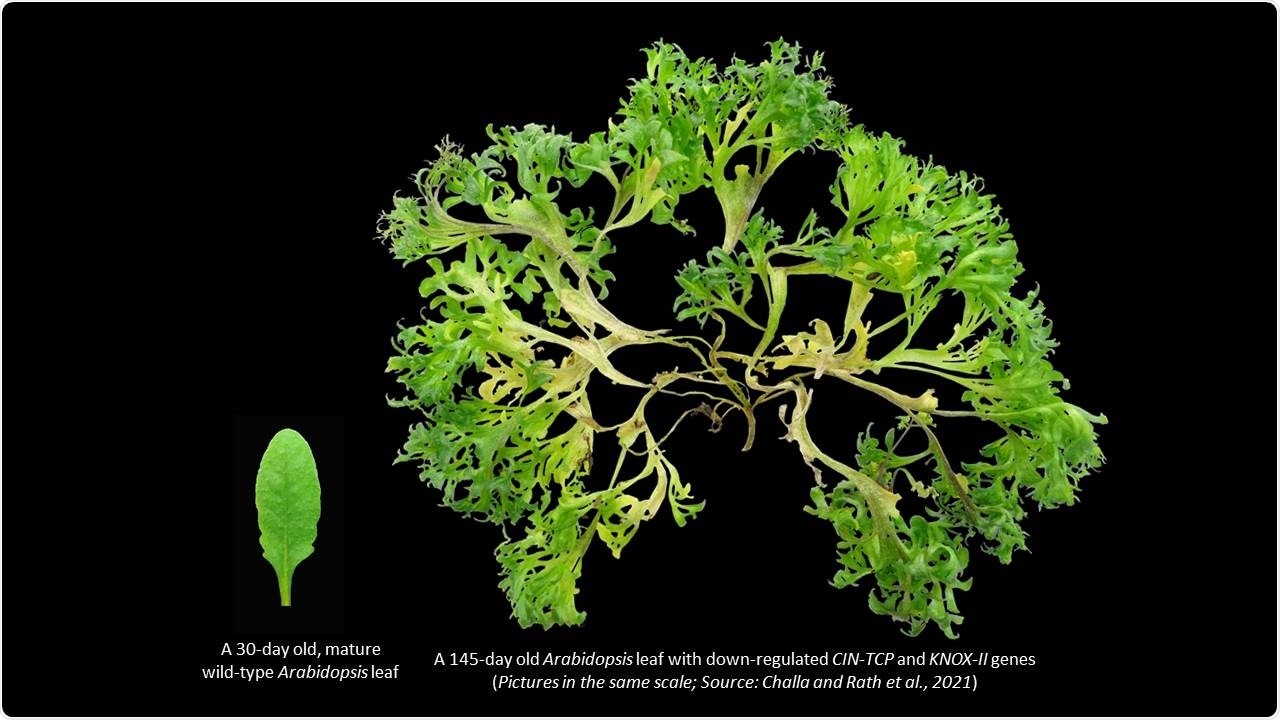Recent research by a research group from the Indian Institute of Science (IISc) elucidates how simple leaves—one of the two basic forms of leaves—originate in a plant. The group includes scientists from the Department of Microbiology and Cell Biology (MCB) and their associates from Shodhaka Life Sciences, Bengaluru.

Image Credit: Krishna Reddy Challa and Monalisha Rath.
The research has been published in the Nature Plants journal.
Plants possess either simple or compound leaves. A mango tree, for example, has simple leaves as they have a single, intact leaf blade. Whereas a Gulmohar tree has compound leaves as the leaf blade is dissected into multiple leaflets.
Yet, both simple and compound leaves start as rod-like structures budding out from the meristem, the tip of the stem where stem cells are found. The process by which these rod-like structures, indicated as primordia, give rise to simple or compound leaves was a subject of many investigations in recent years.
In the current research, the scientists found two gene families that regulate the development of simple leaves through the proteins they code for, in a plant named Arabidopsis thaliana—a well-known model organism in plant biology. These gene families—CIN-TCP and KNOX-II—encode proteins named transcription factors that suppress the development of new leaflets at the margin, consequently giving rise to simple leaves.
The scientists simultaneously suppressed multiple members of the two gene families; this made the simple leaves become super-compound leaves that gave rise to leaflets infinitely. However, when the researchers independently suppressed either of the two gene families, the leaves did not turn into compound leaves, hinting that the genes work in concert.
Furthermore, the mutant leaves remained young and grew for as long as they had the essential growing conditions. Although Arabidopsis leaves typically mature in around 30 days and wither by 60 days, the leaves of these mutant plants with suppressed CIN-TCP and KNOX-II gene families grew for as long as the scientists followed them (175 days)—and could go on for months or years provided the essential conditions.
While scientists have been able to convert compound leaves to simple leaves by manipulating the expression of certain genes, our report is the first one to go the other way around.”
Utpal Nath, Study Senior Author and Associate Professor, Department of Microbiology and Cell Biology, Indian Institute of Science
The authors also discovered that the leaves of the plants in which the two gene families were suppressed, contrary to normal Arabidopsis leaves, showed RNA signatures of young immature leaves and actively dividing cells even beyond their typical maturation period. RNA is a chemical messenger which transmits instructions from the genes necessary to synthesize proteins.
Along with offering insights into plant development, eventually, the results can start and nurture advances in the food industry.
“One could use this technique to alter the shape of the salad leaves as one chooses or increase their biomass. For instance, you could change the shape of a spinach leaf to look like lettuce,” states Krishna Reddy Challa, study co-lead author and a former Ph.D. student at MCB.
Since the leaves don’t mature once the CIN-TCP and KNOX-II genes are suppressed, you can control the longevity of the plant and thereby extend its shelf-life.”
Monalisha Rath, Study Co-Lead Author and PhD Student, Department of Microbiology and Cell Biology, Indian Institute of Science
Source:
Journal reference:
Challa, K. R., et al. (2021) Active suppression of leaflet emergence as a mechanism of simple leaf development. Nature Plants. doi.org/10.1038/s41477-021-00965-3.